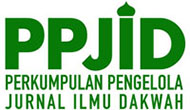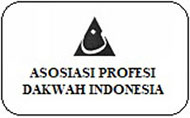Effective Da'wah in the Era of Society 5.0 : The Perspective of Students in Indonesian State Islamic Higher Education
Abstract
This study describes da’wah that is relevant to the era of Society 5.0 from the perspective of State Islamic Higher Education (PTKIN) students in Indonesia. The effective da’wah was raised based on the communication theory by Harold Lasswell, namely the characteristics of da'i (preacher), the media of da’wah, the theme of da’wah, the methods of conveying, and the effects of da’wah. Therefore, this study used a qualitative descriptive approach with observations, interviews, and documentation techniques to collect data. Informants were PTKIN students. This study found several patterns including, first, da’i need to have characteristics such as the obligatory qualities of the Prophet, be exemplary, have charismatic demeanors, and be easy to understand; second, social media is the media of da’wah most favored by students; third, the theme of da’wah must be following the situation and conditions of mad’u (listeners) and be easy to accept and understand; fourth, the methods of conveying da’wah messages are varied and combined; and fifth, the effects of da’wah is not only in the form of information or knowledge but also awareness and feeling—and is followed up with action and practice.
Keywords
Full Text:
PDFReferences
Aisyah, N., & et al. (2022). Multidimensional Dakwah Era Cyberspace Melalui Literasi Digital di Ma’had Aly Nurul Jadid. Jurnal Cendekia, 14(1), 1–14. https://doi.org/https://doi.org/10.37850/cendekia
Aisyah, N., & Rofiah, S. (2022). Dakwah Modern pada Era Konvergensi Media: studi Kasus Youtube Pondok Pesantren Nurul Jadid. Dakwatuna: Jurnal Dakwah Dan Komunikasi Islam, 8(1), 110–126. https://doi.org/https://doi.org/10.54471/dakwatuna.v8i2.1632
Asmar, A. (2020). Ekspresi Keberagaman Online: Media Baru dan Dakwah. Jurnal Ilmu Dakwah, 40(1), 54–64. https://doi.org/https://doi.org/10.21580/jid.v40.1.5298
Aula, L. G., & Abas, Z. (2020). Metode Dakwah Penceramah di Komunitas “Yuk Ngaji” Solo. Academic Journal of Da’wa and Communication, 1(2), 463–478. https://doi.org/https://doi.org/10.22515/ajdc.v1i2.2729
Bakar, N. S. A., & et al. (2022). Challenges in Spreading Knowledge of Dakwah Cyber. Journal of Islamic Education, 7(2), 168–183. https://doi.org/https://doi.org/10.52615/jie.v7i2.268
Berger, A. A. (1995). Essentials of Mass Communication Theory. London: SAGE Publications.
BM, S. A. (2015). Peranan Lembaga Dakwah Kampus dalam Meningkatkan Komunikasi Dakwah Mahasiswa Universitas Islam Negeri Alauddin Makassar. Jurnal Al-Khitabah, 2(1), 71–82. Retrieved from https://journal3.uin-alauddin.ac.id/index.php/Al-Khitabah/issue/view/431
Burhanuddin, A. M., & et al. (2019). Dakwah Melalui Media Sosial. Orasi: Jurnal Dakwah Dan Komunikasi, 10(2), 236–246. https://doi.org/http://dx.doi.org/10.24235/orasi.v10i2.5658
Dianah, S., & Sholeh, S. M. (2022). Analisis Strategi Dakwah Pengurus Masjid al-Firdaus dalam Menghadapi Era Society 5.0. Jurnal Riset Komunikasi Penyiaran Islam, 2(2), 71–78. https://doi.org/https://doi.org/10.29313/jrkpi.vi.1215
Efendi, E., & et al. (2023). Peran Sistem Informasi Terhadap Pengembangan Dakwah Islam. Jurnal Pendidikan Dan Konseling, 5(2), 3230–3238. https://doi.org/https://doi.org/10.31004/jpdk.v5i2.13879
Husna, Z. Z. (2021). Perkembangan Dakwah Melalui Media Sosial Instagram: Literature Review. Ath-Thariq: Jurnal Dakwah Dan Komunikasi, 5(2), 197–208. https://doi.org/https://doi.org/10.32332/ath_thariq.v5i2.3539
Kahfi, S., & Zuliana, V. (2022). Manajemen Dakwah di Dalam Era Society 5.0. Aswalalita: Journal of Dakwah Management, 1(1), 20–40.
Maharani, C., & et al. (2022). Quotes of The Day: Implementasi Model Dakwah Islam Melalui Sosial Media di Era Digital. Journal Scientific of Mandalika, 3(5), 367–374. https://doi.org/https://doi.org/10.36312/10.36312/vol3iss5pp367-374
Mardiana, R. (2020). Daya Tarik Dakwah Digital sebagai Media Dakwah untuk Generasi Milenial. Komunida: Media Komunikasi Dan Dakwah, 10(2), 148–158. https://doi.org/https://doi.org/10.35905/komunida.v10i02.1373
Mazaya, V. (2022). Smart Dakwah di Era Society 5.0: Da’i Virtual dalam New Media. Iqtida’: Journal of Da’wah and Communication, 2(1), 32–46. https://doi.org/https://doi.org/10.28918/iqtida.v2i01.5366
Mubasyaroh. (2017). Strategi Dakwah Persuasif dalam Mengubah Perilaku Masyarakat. Ilmu Dakwah: Academic Journal for Homiletic Studies, 11(2), 311–324. https://doi.org/https://doi.org/10.15575/idajhs.v11i2.2398
Mulauddin, A. (2022). Challenges and Strategies of Muslims in the Era of Society 5.0 in Indonesia. International Conference on Islamic Studies, 3(2), 361–375. Retrieved from https://ejournal.iaforis.or.id/index.php/icois/article/view/153
Naqqiyah, M. S., & et al. (2022). Dakwah Siber dan Pergeseran Religiusitas Masyarakat Kenjeran Surabaya. Jurnal Komunikasi Islam, 12(1), 149–168. https://doi.org/https://doi.org/10.15642/jki.2022.12.1.149-168
Pimay, A., & Savitri, F. M. (2021). Dinamika Dakwah Islam di Era Modern. Jurnal Ilmu Dakwah, 41(1), 43–55. https://doi.org/https://doi.org/10.21580/jid.v41.1.7847
Raqib, M., & et al. (2022). Dakwah Bil Lisan Melalui Media Sosial pada Komunitas Hijrah di Kota Solo. Jurnal Dakwah Dan Komunikasi, 7(2), 129–138. https://doi.org/http://dx.doi.org/10.29240/jdk.v7i2.5767
Rosidi, I. (2021). Da'wah and Politics Among Muslim Preachers in Contemporary Indonesia. Intellectual Discourse, 29(1), 35-52.
Rosyidah, A. (2022). Tantangan dan strategi Dai Muda dalam Berdakwah di Era Digital. Jurnal Al-Tsiqoh: Dakwah Dan Ekonomi, 7(2), 1–11. https://doi.org/http://dx.doi.org/10.21043/at-tabsyir.v8i1.11238
Safitri, F. Z. (2021). Dampak Dakwah di Media Sosial: studi pada Perilaku Keagamaan Mahasiswa Komunitas al-Furqon Fakultas Ilmu Sosial Universitas Negeri Makasar. Panisi Journal of Sociology Education Review, 1(3), 1–7.
Sugiono, S. (2020). Industri Konten Digital dalam Perspektif Society 5.0. Jurnal Ilmu Pengetahuan Dan Teknologi Komunikasi, 22(2), 175–191. https://doi.org/https://doi.org/10.33164/iptekkom.22.2.2020.175-191
Sumadi, E. (2016). Dakwah dan Media Sosial: Menebar Kebaikan Tanpa Diskriminasi. At-Tabsyir: Journal of Islamic Broadcasting Communication, 4(1), 173–190. https://doi.org/http://dx.doi.org/10.21043/at-tabsyir.v1i2.2912
Syaifuddin, & Muhid, A. (2021). Efektifitas Pesan Dakwah di Media Sosial Terhadap Religiusitas Masyarakat Muslim: Analisis Literature Review. Alhadharah: Jurnal Ilmu Dakwah, 20(1), 17–28. https://doi.org/https://dx.doi.org/10.18592/alhadharah.v20i1.4835
Thaib, E. J. (2019). Problems of Da’wah in Social Media in Gorontalo City Communities. Ilmu Dakwah: Academic Journal for Homiletic Studies, 13(1), 37–53. https://doi.org/https://doi.org/10.15575/idajhs.v13i1.4412
Wahab, N. A. (2019). Media Sosial sebagai Medium Dakwah Masa Kini. International Social Science and Humanities Journal, 2(1), 14–23.
Wibowo, A. (2021). Profesionalisme Dai di Era Society 5.0: Mengulas Profil dan Strategi Pengembangan Dakwah. Wardah, 22(1), 1–13. https://doi.org/https://doi.org/10.19109/wardah.v22i1.9003
Wulandari, W. (2022). Implementation of Islamic Education and Wasathiyah Da’wah for Millennial Generation with al-Qur’an Perspective in Facing Society 5.0. Jurnal Pendidikan Agama Islam, 19(1), 129–140. https://doi.org/https://dx.doi.org/10.18592/alhadharah.v20i1.4835
Zaini, A., & Rahmawati, D. (2021). Efektivitas Dakwah Melalui Media Sosial di Era Media Baru. At-Tabsyir: Jurnal Komunikasi Penyiaran Islam, 8(1), 162–172. https://doi.org/http://dx.doi.org/10.21043/at-tabsyir.v8i1.11238
DOI: http://dx.doi.org/10.24014/jdr.v34i1.23277
Refbacks
- There are currently no refbacks.

This work is licensed under a Creative Commons Attribution-ShareAlike 4.0 International License.
Editorial Office:
2nd Floor, Building of Faculty of Da'wah and Communication, Universitas Islam Negeri Sultan Syarif Kasim Riau. Jl. HR Soebrantas Km 15, Simpangbaru, Tampan, Pekanbaru
Email : jurnalrisalah@uin-suska.ac.id

This work is licensed under a Creative Commons Attribution-ShareAlike 4.0 International License.














